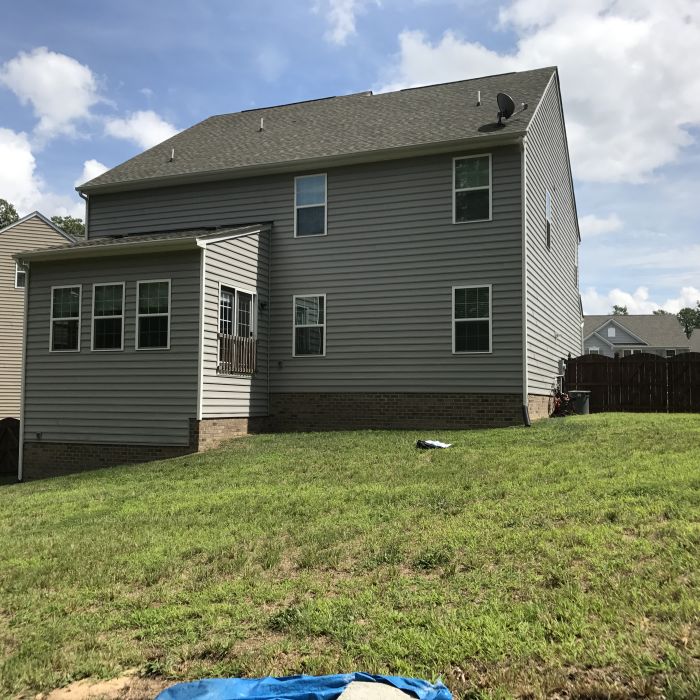Case Study
Mechanicsville Hillside Makeover

Background
The Honey Meadows community is a cute neighborhood filled with young families, parks, and schools within walking distance. It is the perfect place to settle down and start a family.

Client Needs
With one young son and another child on the way, it was important for this growing family to transform their steeply sloped, unusable backyard. Before contacting Outdoor Dreams, the homeowners met with other contractors who told them it would take $80,000+ in just retaining walls to make the backyard usable. Where others saw the need for $80,000+ of retaining walls, Outdoor Dreams created a stunning 3-tiered space full of creativity and function inside that same budget.

Design Phase
The key to making this severely sloped backyard functional and affordable was a thoughtful design that minimized the use of costly retaining walls. Instead of one large wall to flatten the entire backyard, our design made use of a much smaller retaining wall that divided the yard into two functional sections. The plan created the same amount of usable space, but only required 1/4 the amount of retaining wall, leaving the homeowner with room in their budget for more enjoyable features.
Build Phase, Challenges, and Finish
Working on a hillside can be challenging and potentially dangerous. It was essential to adapt our construction methods to the site conditions and plan how to safely use our equipment.

Versatile Wood Deck
Versatile Paver Patio
Retaining Wall with Bench-Style Seating
Native Landscape
Fire Pit
LED Lighting System
Level Playset Area
Stepping Stone Walkway
Herb & Vegetable Boxes
Under-Deck Storage
Additional points of interests
Instead of a hillside nightmare, this new terraced backyard is truly an outdoor dream! The backyard is not only usable, but it is also designed specifically for the young family's enjoyment.

Creating Rustic Polished Casual
With this project, the client wanted a clean space that also blended with the wooded backdrop. To achieve this, we designed the project with a polished casual style and a few rustic touches.
Using native plants was important for creating a relaxed, casual atmosphere as well as blending the space with the woods behind the property. Because the landscape is natural and free-flowing, it was important that the hardscape and deck blend but also provide clean lines and structure.
For the hardscape, the design offers curves that are both flowing and geometric, providing a balance of casual and structure. When selecting materials, the Antika pavers and irregular bluestone provide texture and a rustic touch. To create contrast with the rustic elements, the hardscape features clean-lined materials like the Architectural wall, Valencia fire pit blocks and the BLU 60 Slabs.
Using wood, instead of a plastic material, for the deck gives the structure a natural look and feel. For contrast and additional design sophistication, we used aluminum pickets for the railings and ran the deck boards at a 45-degree angle.
These selections helped create a stunning space that is clean, textured and relaxing.

Choosing a Native Landscape
Outdoor Dreams advocates landscaping with native plants for multiple reasons.
To start, it’s important for most homeowners that landscapes require as little maintenance as possible. Because they are adapted to the local environment and climate, native plants typically require little maintenance, fertilization, and water in order to thrive.
From a design perspective, native plants have a natural look and create a relaxing setting. The natural look of native plants also helps to create a space that effortlessly blends into natural surroundings, like the wooded backdrop of this project.
Most importantly, the use of native plants is beneficial for the environment. North American native plants are disappearing at an alarming rate due to human activities, such as urban development, agribusiness and the introduction of invasive species. The loss of native plant communities has reduced wildlife habitat and the genetic diversity necessary for balanced ecosystems that are essential to our way of life.
Composing a landscape with native plants is an easy, effective and beautiful way to help restore the environment.

A Deck Designed with Features
One of the keys to optimizing this backyard was adding a third tier of usable space. To do this, we designed a deck with multiple features and functions that fully utilizes the space.
The unique layout with centered stairs is designed to create nooks for a grill (not pictured) and a sectional sitting area. Additionally, half of the deck is surrounded with gardening boxes for herbs, vegetables and cut flowers.
The bottom of the deck is latticed to provide a visual barrier, hiding the area under the deck which could easily become an eyesore in this tiered design. The lattice also acts as a trellis feature for the planter boxes, creating support for tomato plants, green bean vines and more.
For additional use of the space, an access door was included in the lattice, allowing the homeowners to use the area under the deck for storage. This additional storage has put off, at least temporarily, the need for a shed.

Making the Most of Every Tier
Coming down off the deck, a second-tier was created to accommodate this specific playset for the family's children. Once thought impossible, the playset sets on a flat area perfect for play. Additionally, just beyond the playset is a mass planting of blueberry bushes that will provide the kids with a nutritious snack while at play.
Benefits of Landscaping with Native Plants
Benefits of Landscaping with Native Plants
Selecting native plants is vital to restoring and preserving a healthy environment. Along with being essential to the environment, the use of native plants has various other benefits that make them advantageous choices. In this article, we outline 10 benefits of using Native Plants.





